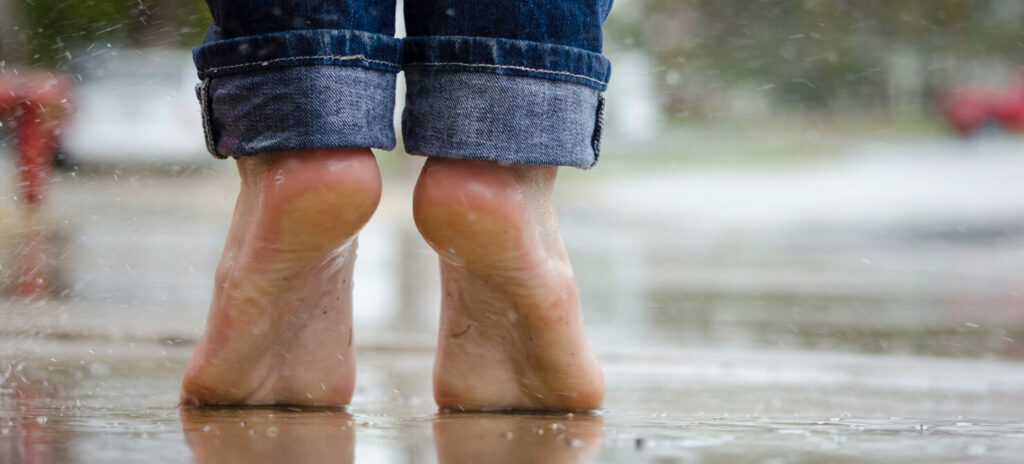Flat Feet

Flat feet, or fallen arches, is a condition where the arch of the foot rolls down toward the floor when a person is standing. Often the arch looks normal if the foot is lifted off the ground. Flat feet is normally a condition that a person is born with, but it can be acquired by injury or dysfunction.
Some people just have a low arch, but with the bones and joints in the foot normally aligned with each other. In a flat foot the bones and joints are not in alignment. A flat foot has a distorted twisted alignment that strains the bones and the ligaments of the arch.
Whereas most people with flat feet don’t have any problems caused by the condition, some people find that walking, running or standing for long periods is painful.
The medical term for flat feet is ‘excessive pronation’.
How do I know if my arches are falling?
Usually you can see a bulge on the inside of the foot. The heels may not be vertically straight but slope away from the leg. The arch on the inside of your foot may reduce in height, or be flat when you stand with the weight on your foot, although often the arch may be high and clearly visible when the foot is off the ground with no weight on the foot, but a wet footprint you leave will show most of the whole of the bottom of your foot.
Free Foot Check
You can book a free foot check with a podiatrist at Fitter Feet for Life. We will examine your feet and tell you if your feet and arches are normal or if you have falling arches or flat feet. You can buy trainers for people who over pronate that help support your foot and arch on the inside. Wearing this type of trainer can reduce foot pains.
Does a Flat Foot Cause Knee Pains?
In some people the legs are forced to turn inwards when the arches fall. This drags the knee inwards and can cause pain in the knee cap or knee joints. Foot orthoses made to sport the arch and correct the knee position and relieve knee pains.
Your podiatrist at Fitter feet will normally advised you to have a filmed gait analysis so that the knee and foot can be examined in freeze frame to access your alignment when you are walking or running.
The Fitter Feet team provide treatment to reduce your pain. Treatment is usually a combination of knee and leg exercises in conjunction with Foot orthoses to correct poor alignment.

Fitter feet for life send Podiatrists to treat injured participants in the London marathon.
Does Flat Foot Cause Hip Pain?
When arches fall, in some people the entire leg turns inwards and changes the axis of the hip and thigh when walking and running. This can lead to Ilio-tibial band syndrome, hip bursitis, degenerative joint changes and inguinal ligament pains.
Most people do not develop all of these symptoms but only one or two. The discomfort or pain is usually worse after exercise.
Returning foot alignment to normal using foot orthoses prescribed to change your walking or running habit, together with strengthening exercises, can relieve a painful hip.
Does Flat Foot Cause Back Pain?
There are several reasons why flat feet may cause back pain, and some people are affected by more than one of them.
Flat feet cause some people have toes that turn out in a ‘ten to two positon,’ leading to a greater sway in your steps from left to right leg. This can cause back pain.
Some times falling arches are not symmetrical, the fall of one arch may be greater in one foot, causing one side of the pelvis to be lower than the other side. It’s like walking with one shoe on and one shoe off. It stresses the joints in the back and causes pain.
When the arch falls the body’s centre of gravity moves forward and tilts in the pelvis increasing pressure in the lower back, creating joint pain.
What can I do about my Back Pain?
Book and appointment so that your gait can be assessed. An analysis of your posture helps diagnose the cause of your back pain. A combination of exercises, core muscle strengthening and foot orthoses can correct an abnormally functioning or tilting pelvis and relieve back pain.
What Is Posterior Tibial Tendon Dysfunction?
The tendon on the inside of the ankle supports the arch. In some people with a falling arch this tendon becomes weak and can fray or break. Depending in on the extent of damage the tendon may recover with a brace, orthoses and physiotherapy. In more advanced cases The Fitter Feet team will request an MRI to assess if a surgical repair is necessary. Our Surgeon, Ms Nicholl FCPodS, works at Guys day surgery NHS and sees private consultations at Fitter Feet for life. She can advise you on the type of flat foot surgery you may need to undergo.
What is Os Naviculare Syndrome?
Os Naviculare Syndrome, or Accessory Navicular Syndrome, is a condition arising from an extra bone on the inside of the foot. This small bone may be separate from, next to or even a part of the navicular bone, and is attached to or embedded in the posterior tibial tendon. Only a small number of people have this extra bone. Many of them also have flat feet. It often causes no problems, but can cause pain, known as accessory navicular syndrome, and then will need to be dealt with, either or non-surgically or by surgery.
The condition is congenital. The syndrome may be brought about by overuse or injury. Having a flat foot puts more strain on the posterior tibial tendon, and this can produce inflammation or irritation of the accessory navicular. Symptoms often appear during adolescence, and include a visible bony prominence, perhaps with redness and swelling, and pain in the midfoot and arch. Fitter Feet will diagnose your symptoms and suggest a course of treatment.
